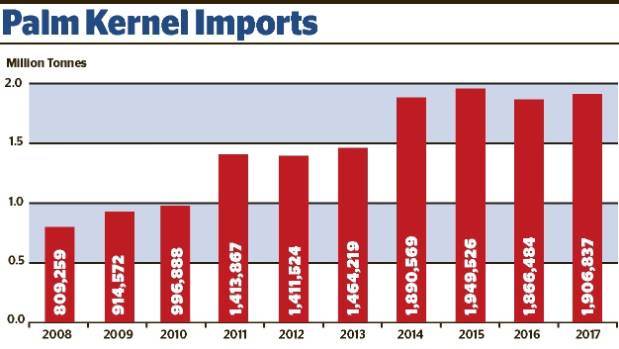Arable farmers are urging dairy farmers to ease up on feeding their cattle imported palm kernel expeller (PKE) in favour of New Zealand-grown grains.
But the fact that PKE is cheaper at $264 per tonne versus wheat ($375) and barley ($385) swings the pendulum in favour of PKE. That is not before transport costs of between $2000-4000 to bring a shipment up from the South Island where most grain is grown. The call comes as the signs are promising for the industry after two indifferent seasons.
“We’re keen farmers see grain as an option, PKE has environmental and biosecurity issues, and Fonterra has problems with it for milk composition. We’ve got domestic grain available, it’s quality feed and has none of those issues,” Federated Farmers Grains vice-chairman Brian Leadley said.

Feds dairy group chairman Chris Lewis said farmers would “love” to feed grain, and many South Island farmers did, but freight costs made it prohibitive for North Islanders. However, he and other farmers added Canterbury grain into their PKE meal silo blends.
The latest industry survey shows the total area sown in cereals is estimated to be up 19 per cent, or 20,500 hectares on last season, mainly due to an increase in the area sown in feed barley, which is returning to historical levels. The total hectares producing all six cereal crops – feed barley, malting barley, milling wheat, feed wheat, milling oats and feed oats – should be 128,700ha.
By the first week of October, 81 per cent of sowings had been completed. Wet weather delayed putting crops in the ground in many regions, with later crops sown in less than ideal conditions. The percentage of hectares that have been forward sold is estimated to be 90 per cent for malting barley, 78 per cent for milling oats and 43 per cent for milling wheat. For the feed crops, the percentages that had been forward sold were 46 per cent of feed wheat, 43 per cent of feed barley and 26 per cent of feed oats.
“There has been reluctance among growers towards the barley market. But this present wet spring has actually prompted many to plant barley as they’ve been unable to plant other vegetable crops in sodden conditions,” Leadley said.
By April next year yields could yet be compromised, depending on how late planting was and if spring crops had been firmly established so they would be resilient enough to get through warm, dry spells. While there was a lift in demand and price, Leadley said that might not be the case after this summer’s harvest.
“I think the end users are still cautious and maybe even cash tight. So if they are buying, its more on requirement than opportunity, I doubt most have or are thinking of filling up their silos.
“The long-term forecast is a La Nina cycle. This may mean drought type conditions for some, so I would encourage farmers to contact local suppliers to secure domestically produced cereal grain that is of a quality standard.”
He said the recent increase in biosecurity incursions was a logical reason for reducing imports.
“The reality is one contaminated import can have long-term implications especially with costs and managing it. You can reduce this risk by buying locally and knowing it’s from a reputable grower,” Leadley said.
Source: NZFarmer.com




